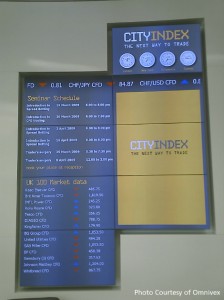We first mentioned the Issy-Neale Formula when describing the make-up of large video walls and now that we have seen a couple more odd-shaped, non rectangular shaped screen designs, the latest of which was an Omnivex inspired Z shape, shown below we thought it worthwhile to spend just a little bit of time describing how the formula actually works.
This is just a quick guide to give you the idea as we will be exploring the formula in much more detail soon.
Each screen unit in the whole display we are calling a tile (T). This tile element can be an individual plasma or LCD screen, an LED unit, or a unit of any other display system technology. For example, how about a really big display using edge-blended video projectors – each projector would be a tile element.
Taking the screen display as a whole, think of drawing the display on squared paper and shade in each square where you have a tile (screen unit), then draw the smallest possible rectangle around the whole lot to enclose all of the display without gaps at the edges. Now think of a rectangular video image stretched over the whole display – ingore any potential aspect ratio stretching of the image for the moment.
In the case of the Omnivex screen above, you would have two spaces in the rectangular grid of the video image where there are no screen tiles – these we call holes (H).
Using these elements, the formula is designed to describe two key things:
- the overall size and aspect ratio of the screen in terms of screen elements, or tiles (we are of course assuming that the tiles themselves are rectangular so you can actually fit them seemlessly together)
- where you have the tiles and holes for non standard shaped screens (standard rectangular screens will be all tiles, non rectangular screens like the Omnivex screen will have both tiles and holes)
Those more mathematically minded among you are probably already figuring out how this is all working. With these two pieces of information, you can then easily describe any whole screen display, rectangular shaped or not – rectangular includes square by definition of course, Ed
We’ll be covering the significance of this soon in another post!
The ‘Issy-Neale Formula’ Explained Part 1
The ‘Issy-Neale Formula’ Explained Part 2
The ‘Issy-Neale Formula’ Explained Part 3


Follow DailyDOOH